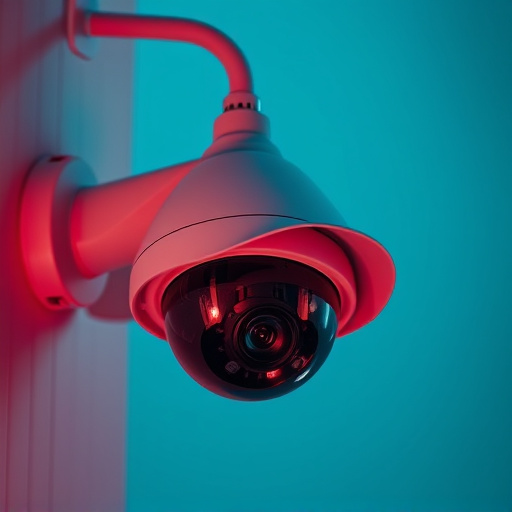In today's digital age, mounting realistic fake security cameras on brick facades offers a cost-effective deterrent for residential and commercial properties. Understanding brick types, selecting durable materials, and using specialized installation techniques ensure secure and undetectable placements. However, it's crucial to consider local laws and privacy regulations when utilizing this method, focusing on discreet mounts to avoid legal issues.
In today’s security-conscious world, mounting fake cameras has become a popular deterrence measure. Understanding the need for fake security camera mounting brackets is essential, especially when aiming to protect properties with brick surfaces. This article delves into the art of disguising these devices seamlessly while addressing various challenges, from different brick types to legal considerations. We explore effective installation techniques and guide you through choosing the right materials, ensuring both durability and realism in Mounting Fake Cameras on Brick.
- Understanding the Need for Fake Security Camera Mounting Brackets
- Types of Brick Surfaces and Their Impact on Mounting
- Choosing the Right Material for Durability and Disguise
- Installation Techniques for Secure and Covert Placement
- Legal Considerations and Best Practices for Using Fake Cameras
Understanding the Need for Fake Security Camera Mounting Brackets
In today’s digital era, where security is paramount for both residential and commercial properties, mounting fake security cameras has become a clever strategy to deter potential criminals. While actual camera installations offer robust security measures, fake brackets serve as an effective visual deterrent. Understanding how to Mounting Fake Cameras on Brick is crucial for property owners looking to enhance their home or business’s security without the cost and complexity of professional surveillance systems.
These fake mounting brackets are designed to resemble genuine security camera mounts, strategically placed in visible areas to trick intruders. By simulating the presence of surveillance equipment, they create a perception of heightened security, potentially discouraging criminal activities. This simple yet ingenious approach is particularly valuable for areas with brick facades, offering a discrete and cost-efficient solution to deter unauthorized access.
Types of Brick Surfaces and Their Impact on Mounting
When mounting fake security cameras on brick surfaces, understanding the various types of brick and their unique characteristics is essential. Different brick materials and finishes can significantly impact the stability and durability of the camera mounts. For instance, smooth or glazed bricks may require specialized adhesive or brackets designed for non-porous surfaces to ensure a secure fit. On the other hand, textured or rough brick surfaces offer better mechanical grip, allowing for simpler mounting with standard hardware.
The age and condition of the brickwork also play a role. Older buildings might feature handmade or reclaimed bricks with varied dimensions and irregular shapes, which can complicate mounting. Newer constructions often have machine-made bricks with consistent sizes, making installation easier. Additionally, factors like moisture content in the brick, proper drainage, and environmental conditions must be considered to prevent damage to both the camera equipment and the mounting brackets over time.
Choosing the Right Material for Durability and Disguise
When mounting fake security cameras, especially on brick surfaces, choosing the right material is paramount for both durability and disguise. Opt for high-quality, weather-resistant plastics or polymers designed to mimic real metal or plastic components. These materials not only endure outdoor conditions but also blend seamlessly with brick walls, ensuring your fake camera setup remains undetected.
For a more authentic look when mounting fake cameras on brick, consider textured surfaces that replicate the roughness of actual brick. This subtle detail can significantly enhance the overall realism, making it harder for passersby to distinguish between genuine and imitation security gear. Always select brackets with sturdy fasteners to secure the camera firmly in place, protecting your investment from potential theft or damage.
Installation Techniques for Secure and Covert Placement
When mounting fake security cameras, especially on brick surfaces, understanding installation techniques is crucial for both secure and covert placement. One effective method involves using specialized adhesive compounds designed to bond strongly with brick. These adhesives are ideal for indoor and outdoor applications, ensuring the camera remains steadfast even in varying weather conditions. It’s important to choose an adhesive suitable for your specific type of fake camera and brick material to achieve optimal adhesion.
For a more permanent solution, consider mechanical fasteners like metal brackets or screws. This approach is particularly useful when mounting cameras on solid brick walls. Pre-drilling pilot holes can prevent cracking while securing the bracket firmly in place. Additionally, using decorative bricks or tiles that match the existing facade can help camouflage the mounting points, making it harder for intruders to identify the camera’s location.
Legal Considerations and Best Practices for Using Fake Cameras
Using fake security cameras and their mounting brackets can be an effective deterrent for potential criminals, but it’s crucial to navigate legal considerations and best practices. Before installing any fake camera equipment, especially on brick surfaces, property owners should familiarize themselves with local laws regarding surveillance technology. Some jurisdictions have specific regulations on the placement and visibility of security cameras to protect privacy rights.
Best practices dictate that mounting fake cameras on brick structures should be done discreetly without drawing unnecessary attention. This involves positioning the brackets in such a way that they don’t stand out as fake or easily removable. It’s also essential to ensure the stability of the bracket to prevent vandalism or dislodging, which could lead to legal issues related to false security claims or liability for any resulting damage.
Mounting fake security cameras on brick surfaces requires a strategic approach that considers material, installation, and legal aspects. By understanding the impact of various brick types and choosing durable, disguise-oriented materials, you can achieve secure and covert placement. Adhering to best practices and legal considerations ensures effective deterrence without compromising aesthetics. When implemented correctly, fake camera mounting brackets can be a game-changer in enhancing home or business security while maintaining an unobtrusive appearance.
